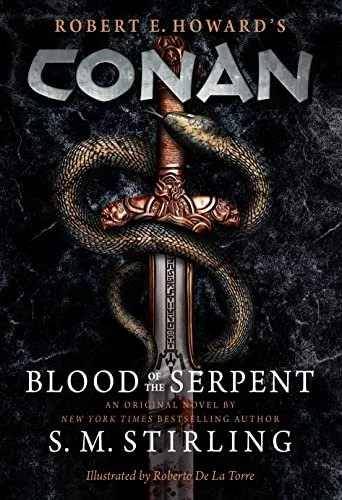A Review of Titan Books’ Blood of the Serpent: Is the New Conan Novel Really Conan?
Blood of the Serpent is the semi-anticipated latest entry in the prose adventures of Conan of Cimmeria. We’ve had recent video games, RPGs, comics, etc., featuring the barbarian, but the last original standalone authorized prose work of Robert E. Howard’s greatest creation was, as I understand it, Harry Turtledove’s Conan of Venarium (Tor, 2003).
Some 20 years later publisher Titan Books and author S.M. Stirling stepped up to fill the gap with Blood of the Serpent, published Dec. 2022.
How is it? My quick review: 3.5/5 stars. Maybe 4/5. A good book, worth reading, albeit one that did not quite hit with the impact I was hoping for.
I like the conceit, which is relaying the events directly preceding Robert E. Howard’s classic story “Red Nails.” Titan republished “Red Nails” here in the book in full, appending the story to the end of Stirling’s tale. If continuity is your thing you get it here.
I like the prose. Stirling is a good writer, and the book reads well. This is no small feat; the most difficult and important box has been checked. The story is a page turner. I did not struggle to get engaged with the tale, and looked forward to each reading session (it’s a brisk 300 pages with illustrations). It moves apace.
The hardcover presentation is terrific. I like the cover myself, even if it feels slightly generic high fantasy. The Atlantean sword callback to CtB 1982 will raise the hackles of some purists but it’s a well-rendered image. And the interior black-and-white art by Roberto De La Torre evokes the John Buscema illustrated Conan the Barbarian comics of the 1970s. Add in maps and other supporting material including “Red Nails,” and it’s a nice package of Hyborian Age goodness.
So, well-written page turner in a nice package gets the book to its present rating. But that’s where it stays for me.
My biggest issue with Blood of the Serpent is that not a whole lot happens. To be fair short adventures in which the fate of the world does not hang in the balance is a hallmark of sword-and-sorcery. I’m fine with the lack of epic events, and I don’t need or want Conan slaying dark lords and saving the world. But for a property like this, and a publishing gap this big for a character this anticipated, I was expecting more. “Red Nails” for example packs far more plot, wild weirdness, and imagination into 1/3 the length.
Blood of the Serpent is essentially an extended chase through the jungle with Conan attempting to hunt and kill a man intent on murdering Valeria. This entails multiple encounters with wild beasts, including as you’d expect giant man-eating apes and serpents, but also large predatory cats, a rhino, crocodiles, baboons… on and on (the overly aggressive animals are due to a curse laid upon Conan by a Stygian wizard). Some have compared the novel to an extended African big-game jungle safari and it does have that feel. Extended sequences of meat-butchering and food preparation and other such details feel non-Howardian, giving the novel a gritter and more grounded/modern feel at the expense of the poetry, romance, and mythic aura of Howard’s best prose.
I enjoyed Stirling’s bold choice to tell the story in Conan’s headspace, offering the reader Conan’s interior thoughts (which often revolve around a desire to get into Valeria’s pants). I think Stirling channels Conan well enough here; it’s not Howard, but I also don’t think a pastiche author should try to copy the original authors’ style. Channel the character, yes, and the Hyborian Age, but there was only one Robert E. Howard.
I think Stirling channels Conan the character well enough: He prefers to work alone, has a barbarian’s distrust of civilization, fears sorcery, is lusty and wealth-seeking, but underneath is possessed of a rough code of honor. He’s no murderer or slaver, and when his companions in arms are taken captive or placed in jeopardy, Conan comes to their rescue. In an afterword Stirling shares a bit about his life-long love of the character. A veteran author of many novels, Stirling’s first attempt was a “truly terrible Howardian pastiche” at age 13. “I hope decades of experience have finally made me worthy to be allowed into the master’s playpen,” Stirling writes. From my perspective he did a credible job of delivering more Hyborian Age action.
We get some finely rendered fight scenes, and much blood and gore. And of course it’s Conan, this is a character we bring a lot to as readers, and it’s wonderful to experience new adventures with him again. I liked the callbacks to Conan’s previous adventures, which include the likes of “Rogues in the House” and “Tower of the Elephant,” among other easter-eggs.
Blood of the Serpent is a good read most will probably enjoy. Kudos to Titan for getting it out; I do think the publisher could have done much more to promote it (the hype for its release was almost non-existent from my perspective, although I might have missed something), and I wish they gave Stirling additional leash to tell a more substantial story. I get the sense it has fallen far short of a Brandon Sanderson-like sales response; I hope it’s at least moderately profitable. How much of an impact it ultimately makes remains to be seen, although Titan Books has evidently committed to a series. More quality Conan is always welcomed.
Brian Murphy is the author of Flame and Crimson: A History of Sword-and-Sorcery (Pulp Hero Press). Learn more about his life and work on his website, The Silver Key.



